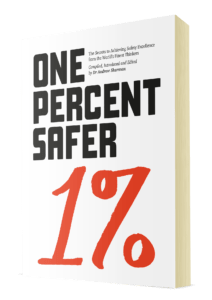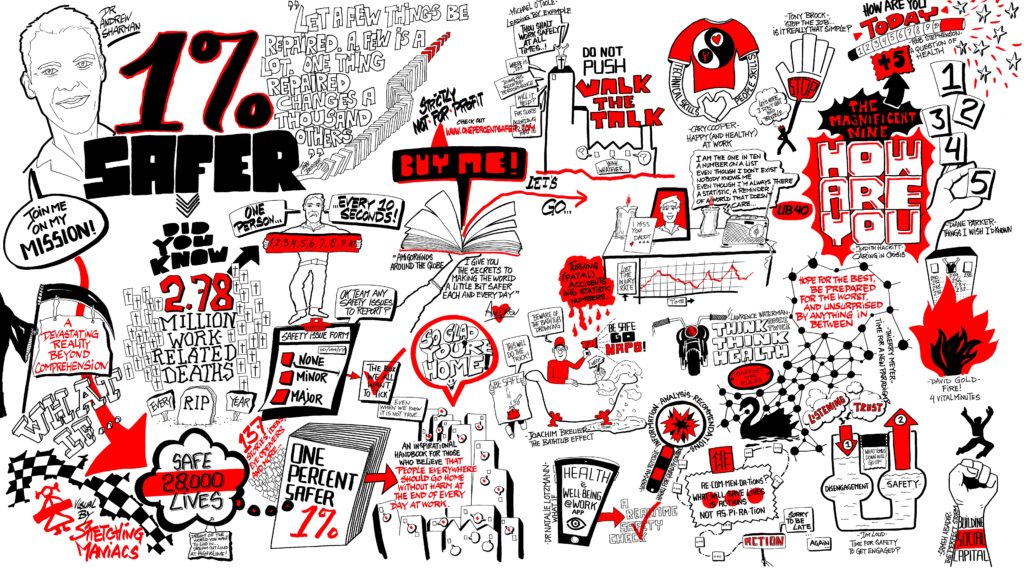Seek to understand
Louis Wustemann spoke to  James Pomeroy, Group Health, Safety, Environment and Security Director at Lloyd’s Register, who, in his chapter of the book, says that on his pre-COVID daily commute into London he passed the bronze statue of the unknown building worker erected at Tower Hill to commemorate the millions of lives lost at work. “As I stare at the statue, I wonder what the worker could tell us about keeping safe,” he muses.
James Pomeroy, Group Health, Safety, Environment and Security Director at Lloyd’s Register, who, in his chapter of the book, says that on his pre-COVID daily commute into London he passed the bronze statue of the unknown building worker erected at Tower Hill to commemorate the millions of lives lost at work. “As I stare at the statue, I wonder what the worker could tell us about keeping safe,” he muses.
The value of listening to – and learning from – Frontline workers is a theme that emerges again and again in One Percent Safer’s 137 chapters. Their insights into how workplace safety and health could be boosted to help reduce the global occupational fatality total by just one percentage point a year are shot through with messages about humility and listening to those who manage work risks minute to minute.
James Pomeroy, goes on to argue that as safety practitioners, “We must seek to understand before seeking to be understood”, quoting Steven Covey, author of the bestselling self-help book The Seven Habits of Truly Effective People. Covey, in turn, was echoing a sentiment found in a prayer sometimes attributed to St Francis of Assisi. If the wish is an often-repeated one that’s because it contains a useful truth: that you learn more while listening than talking.
Safety and Health professionals spend years in many cases studying the interplay between human activity and a long schedule of hazards, from sharp objects to airborne pollutants to gravity (in the case of work at height). OSH practitioners can become the centres of risk-evaluation excellence in their organisations. But the missing link is always the way that a specific group of employees perform a task in a particular workspace and the pressures acting on them. One thing is for sure: they will not always be following a prescribed set of instructions.
James Pomeroy alludes to the major study funded by the Institution of Occupational Safety and Health and published in 2016. Professor Alistair Gibb – another contributor to the One Percent Safer book – and colleagues at Loughborough University, examined logistics companies, healthcare trusts and construction firms and found that workers in lower-risk jobs often adapted practices to reduce risk to themselves.
The study distinguished between unsafe shortcuts and these “workarounds”, which commonly develop as a reaction to unwieldy work systems or safety controls and are trying to meet the spirit of safety systems if not the letter. OSH practitioners shouldn’t try to stamp out workarounds, the authors suggest, but could learn from and support them: “Rather than trying to manage uncertainty by increasingly detailed and prescriptive regulation, it may be more productive to concentrate on supporting and enabling workers to become more skilful at improvising methods of achieving safety goals.”
Field studies
Learning how work is actually carried out is the last piece in the jigsaw of risk management; it’s essential field research. In her chapter in One Percent Safer, consultant and trainer Bridget Leathley makes the case for spending extra time on task analysis on site to ensure you have a rounded picture of the activity you are risk assessing. “If you base your hazard identification on your idea of what people do when they change a fuse, rather than what they actually do, you will miss something.”
It is possible for OSH professionals to see direct consultation with people doing the job as ceding some of their authority as risk experts, but they could choose to view it as building on their expertise with data they can only gather from one source.
It’s also potentially an important building block of a sound safety culture. If an organisation wants everyone it employs to “own” the importance of keeping themselves and colleagues from harm, then everyone has to feel involved in the process of risk control.
“By asking workers questions, we might also find common ground and common language between managers, OSH practitioners and the frontline,” says. Drew Rae, Senior Lecturer at Griffith University in Australia, in a One Percent Safer contribution that nudges practitioners to ask workers which safety practice they find most annoying.
“Many of the industry challenges that we face require cross-fertilisation of ideas, bottom up engagement and collaboration with new partners,” add organisational systems experts Mieke Jacobs and Paul Zonneveld in a contribution setting out the questions leaders should ask themselves.
Taking the pledge

All profits from the sale of the book go directly to the One Percent Safer Foundation, an independently-governed charitable fund. Andrew Shaman said: “The Foundation will disperse the money to people that need a bit of extra support. There are two separate categories, the first is practical help in the form of small grants or support and professional education for OSH practitioners that have become vulnerable and lost their jobs because of the coronavirus pandemic. And then, the second group that we’re encouraging to apply for the provision of small grants of seed capital or help with educational training and support for organisations in the third sector, not for profits, charitable institutions and social. Details on how to apply for a grant or support is on the website.”
The website set up to promote the One Percent Safer principle – onepercentsafer.com – asked visitors to submit ideas they believed would contribute to improving safety and health in their workplaces. The importance of listening emerged as a popular theme there too.
“I work on the principle that people really are the answer to making the workplace safer, but only when we let them contribute!” wrote Wayne Jones, Group ESH Manager at Welsh forestry business BSW Timber. “Why should it be that management write all the rules when management have never operated the same equipment, driven the same machinery or worked in the same conditions?”
“I am going to keep talking with everyone and trying to engage with them about health and safety,” pledged Sarah Barnes, Health and Safety Technician at chemicals manufacturer Eftec. “It’s all very well talking at people but listening and comprehending is just as important. Before explaining why something is unsafe, ask why.”
Amjad Awwad, Operational Integrity Manager, SGS North America Inc said he would improve workplace safety “By being an active and empathetic listener through placing myself in another person’s shoes. Only through walking the walk after talking the talk would the message and true intent of safety hit home and get woven into the fabric of our behaviours and habits.”
The pithiest contribution came from safety consultant Abby Ferri, who hosts the Safety Justice League podcast in the US: “More listening! Our people have the solutions, safety isn’t rocket science.”
This collaboration and mutual support between subject specialists, general management and frontline workers was critical to the fast response by so many organisations to the challenges of the first stages of the Covid pandemic. It is also likely to be a key feature of those which bounce back as mass vaccination allows normal levels of economic activity to resume.
For those of us in the One Percent Safer movement that has grown out of the book, collaboration is one of the cornerstones or our work to help safety and health professionals make a one percent dent in the global fatality rate. If you are interested in joining the movement, buying the book –
profits go to support OSH professionals disadvantaged by the pandemic – or just finding out more about the One Percent Safer principle, visit onepercentsafer.com.
By Ian Hart and Louis Wustemann.
 Professor Dr Andrew Sharman, the creator and curator of the project, explained the premise behind One Percent Safer in episode three of the Safety & Health Podcast. We recently caught up with Andrew, and contributor Malcolm Staves, Corporate Health and Safety Director at L’Oreal, to get an update on the book, the foundation and what’s to come.
Professor Dr Andrew Sharman, the creator and curator of the project, explained the premise behind One Percent Safer in episode three of the Safety & Health Podcast. We recently caught up with Andrew, and contributor Malcolm Staves, Corporate Health and Safety Director at L’Oreal, to get an update on the book, the foundation and what’s to come.
 James Pomeroy, Group Health, Safety, Environment and Security Director at Lloyd’s Register, who, in his chapter of the book, says that on his pre-COVID daily commute into London he passed the bronze statue of the unknown building worker erected at Tower Hill to commemorate the millions of lives lost at work. “As I stare at the statue, I wonder what the worker could tell us about keeping safe,” he muses.
James Pomeroy, Group Health, Safety, Environment and Security Director at Lloyd’s Register, who, in his chapter of the book, says that on his pre-COVID daily commute into London he passed the bronze statue of the unknown building worker erected at Tower Hill to commemorate the millions of lives lost at work. “As I stare at the statue, I wonder what the worker could tell us about keeping safe,” he muses.